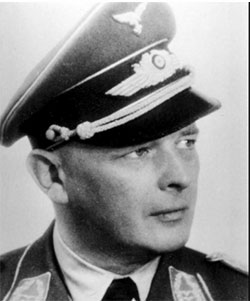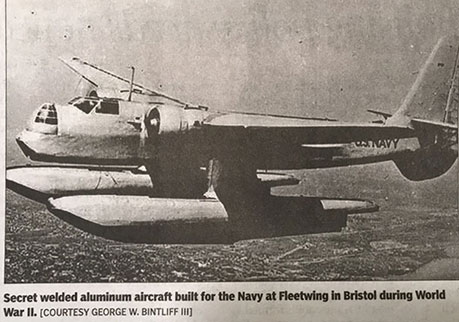THANK YOU!
YOUR PURCHASE OF THESE BOOKS SUPPORTS THE WEB SITES THAT BRING TO YOU THE HISTORY BEHIND OLD AIRFIELD REGISTERS
Your copy of the Davis-Monthan Airfield Register 1925-1936 with all the pilots' signatures and helpful cross-references to pilots and their aircraft is available at the link. 375 pages with black & white photographs and extensive tables
---o0o---
The Congress of Ghosts (available as eBook) is an anniversary celebration for 2010. It is an historical biography, that celebrates the 5th year online of www.dmairfield.org and the 10th year of effort on the project dedicated to analyze and exhibit the history embodied in the Register of the Davis-Monthan Airfield, Tucson, AZ. This book includes over thirty people, aircraft and events that swirled through Tucson between 1925 and 1936. It includes across 277 pages previously unpublished photographs and texts, and facsimiles of personal letters, diaries and military orders. Order your copy at the link.
---o0o---
Military Aircraft of the Davis Monthan Register 1925-1936 is available at the link. This book describes and illustrates with black & white photographs the majority of military aircraft that landed at the Davis-Monthan Airfield between 1925 and 1936. The book includes biographies of some of the pilots who flew the aircraft to Tucson as well as extensive listings of all the pilots and airplanes. Use this FORM to order a copy signed by the author, while supplies last.
---o0o---
Art Goebel's Own Story by Art Goebel (edited by G.W. Hyatt) is written in language that expands for us his life as a Golden Age aviation entrepreneur, who used his aviation exploits to build a business around his passion. Available as a free download at the link.
---o0o---
Winners' Viewpoints: The Great 1927 Trans-Pacific Dole Race (available as eBook) is available at the link. This book describes and illustrates with black & white photographs the majority of military aircraft that landed at the Davis-Monthan Airfield between 1925 and 1936. The book includes biographies of some of the pilots who flew the aircraft to Tucson as well as extensive listings of all the pilots and airplanes. Use this FORM to order a copy signed by the author, while supplies last.
---o0o---
Clover Field: The first Century of Aviation in the Golden State (available in paperback) With the 100th anniversary in 2017 of the use of Clover Field as a place to land aircraft in Santa Monica, this book celebrates that use by exploring some of the people and aircraft that made the airport great. 281 pages, black & white photographs.
---o0o---
YOU CAN HELP
I'm looking for information and photographs of pilot Engle and his airplane to include on this page. If you have some you'd like to share, please click this FORM to contact me.
---o0o---
Thanks to Guest Editor Bob Woodling for help researching this page.
---o0o---
SPONSORED LINKS
HELP KEEP THESE WEB SITES ONLINE
FOR YOUR CONVENIENCE
You may NOW donate via PAYPAL by clicking the "Donate" icon below and using your credit card. You may use your card or your PAYPAL account. You are not required to have a PAYPAL account to donate.
When your donation clears the PAYPAL system, a certified receipt from Delta Mike Airfield, Inc. will be emailed to you for your tax purposes.
---o0o---
WILLIAM HARRY ENGLE
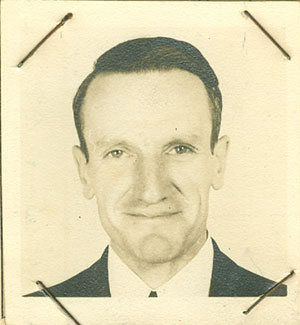 |
Bill Engle landed twice at Willow Grove. The first time, on Thursday May 8, 1930, he flew the Fairchild KR-31 he identified as NC284K (S/N 323). Based at Philadelphia, PA, he left no information about his destination that day. Neither did he mention passengers.
His second visit was about 12 years later on Saturday, January 24, 1942. This time he did not identify his passengers or his airplane by either make or registration number, but he identified his home base as Langhorne, PA and his destination as Pitcairn Field.
But, thanks to Engle's son, we have his pilot log book #4, below, that confirms, on the day of his second landing, that he flew a Fleetwings XBT-12, which wore Army registration number 39-0719.
The XBT-12, and 39-0719 specifically, was a prototype training aircraft, and was a product of the Kaiser-Fleetwings Company (1926-1962) . It was a tandem cockpit airplane, powered by a Pratt & Whitney R-985 radial engine. Engle was a test pilot for Kaiser-Fleetwings.
Uniquely, 39-0719 was the first aircraft built for the military that was fabricated of stainless steel.. On February 21, 1944, 39-0719 was taken out of service and used for training ground maintenance personnel. Joe Baugher's site states that this airplane is (was?) part of the now inactive Walter Soplata Collection, Newbury, OH. I read through the article at the link, but saw no reference to the airplane. But see this link for images of the airframe from the 1970 & 80s at Soplata's property.
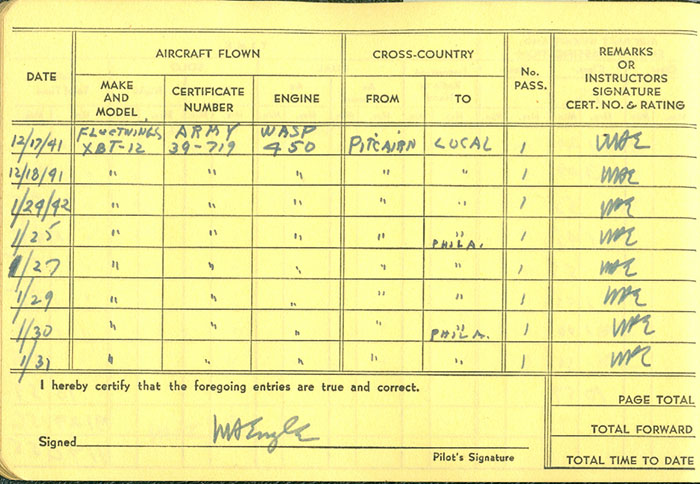 |
A public domain Web photograph of 39-0719 is below. Although undated, the snow says winter, maybe January 24, 1942. Regardless, this is the aircraft Engle flew to Willow Grove. What is clear from Engle's log, is that he visited Pitcairn Field several other times with the airplane in January 1942, yet signed the Register only on the 24th.
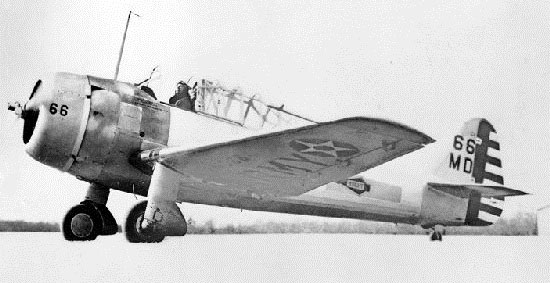 |
In fact, Engle earlier flew this airplane for much of 1941. As well as at Pitcairn Field, his Pilot Logbook #4 documents flying 39-719 to Roosevelt Field, Mineola, NY and Middletown in New York and Wright Field in Dayton, OH.
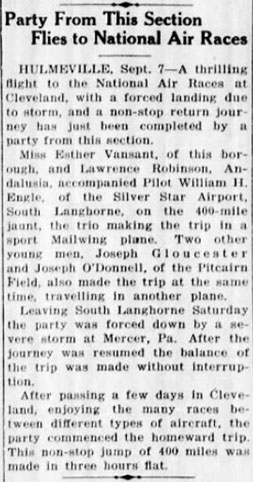 |
Similarly, his logbook #4 records flight with Fleetwings Seabirds NC19191 and NX29003, and a Taylorcraft, NC27442. You can read specifically about this earlier Fleetwings Seabird model in this REFERENCE, volume 7, page 277ff. A motion picture of a Fleetwings Seabird is at the link. The airplane in the footage is NC16793, the first Seabird manufactured. It was not a Register airplane.
I've cited Engle's flight logbooks a couple of times. What about them? Engle's son shares seven of them with us. Each is linked below to a PDF which exhibits color images of each page.
Logbook #1 (41 pages, April 17, 1931 - October 20, 1934) Logbook #1 begins with 771 hours logged before April 17th. Interestingly, on pp. 40-41, Engle recorded a flight from Pennsysvania to the 1934 Cleveland Air Races (NAR). A news article from the Bristol Daily Courier (PA), September 7, 1934, right, reported on that flight. Mentioned is Esther Van Sant, who would become Mrs. Engle in 1938 (see photograph below).
Logbook #2 (35 Pages; October 21, 1934 - December 17, 1938: PDF 8.6Mb; some entries out of order). Most of his flying through 1937 was instructional, for basic and instrument students.
The cross-country flights to and from the 1935 NAR were logged on page 5 of the PDF (see below) . The flights occurred on August 31st and September 5, 1935. He flew the Pitcairn Mailwing NC10377.
On March 25, 1937, he logged his first flight with NX16793, the prototype Fleetwings Seabird S/N F-401. Flights for Fleetwings picked up and log #2 showed about a quarter for Fleetwings and the rest instructional flights in June.
Significant for Fleetwings was the flight on July 6, 1937 on which the airplane earned the Department of Commerce (DOC) Aircraft Type Certificate (ATC) on NX16793, thus making copies of the airplane commercially available. The ATC was officially conferred by the DOC on October 30, 1937. In the early spring of 1938 he again began flying steadily for Fleetwings with nearly 100% of his logged flights being in their aircraft until the log ends.
Logbook #3 (27 Pages; January 23, 1939 - December 16, 1939: PDF 4.5Mb; some entries out of order). Logbook #3 begins auspiciously with test flights with Fleetwings CF-BGZ (not a Register ailplane) in preparation for its sale to a Canadian mining company. Later in the spring of 1939 he twice flew Fleetwings NC19191 (not a Register airplane) to Florida, Cuba and the Bahamas (see below). This was probably a welcome assignment while the north remained in the throes of a Pennsylvania winter. All but a handful of flights recorded through the rest of this log were in Fleetwings.
Logbook #4 (28 Pages; December 14, 1939 - July 25, 1941; PDF 5.5Mb; some entries out of order). Early 1940 was spent in Fleetwings and other craft performing demonstrations and providing instruction. That pattern persisted through the fall and into December. From January to July 1941 he logged flights exclusively in Fleetwings.
Logbook #5 (26 pages; May 11, 1941 - April 27, 1942 PDF 5.2Mb; some entries out of order). Test filghts of new Fleetwings NX29033 on July 25, 1941 and ff. Fleetwings NC19191 is logged again on page 13.
Logbook #6 (30 pages; June 16, 1943 - April 10, 1945 PDF 5.6Mb; some entries out of order).
Logbook #7 ( 26 pages; April 12, 1945 - October 17, 1947 PDF 2.1Mb; some entries out of order. The very first entry is historic. It documents the first flight of the Kaiser-Fleetwings XBTK-1 dive/torpedo bomber on April 12, 1945. The Wikipedia entry for the XBTK states, "The first XBTK-1 was finally completed in March 1945, making its first flight on 12 April 1945." Now we know who flew the airplane. And this was not pilot Engles' first contact with this brand new airplane.
From April 1945 to June 1946 Engle performed extensive XBTK-1 tests including stalls & spins with both prototypes, some comparison flights with the Curtiss Helldiver (cf. also Logbook #6), and comparison flights with the Douglas Dauntless (SBD).
The final entry in his Logbook #6 on April 10, 1945 states that he guided the XBTK-1 through a 'Taxi Run" on the ground. This new plane was identified as Navy 44-313 according to Joe Baugher's site.
The few flights in Douglas SBD Dauntless models, namely 28-427 and 36-340, may have something to do with the following thoughts offered by Engles's son. Neither of the SBD identifiers are listed at Joe Baugher's site.
"My understanding of "the end" of Dad's testing career has been modified after reading this logbook. He told me his testing career ended after needing to use a spin chute during a dive bomber test that cause him to hemorrhage from his lungs. I thought it was immediate. I assumed he lost his medical certificate.
|
|---|
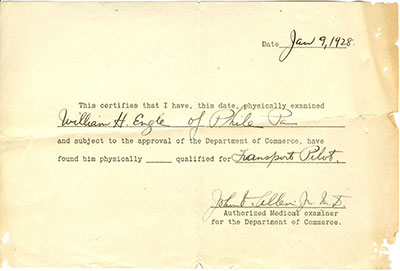 |
At right is his Medical Certificate for 1928.
As noted above, we have a photograph of Engle, Vansant and Robinson (not a Register signer), below, on the ground in Cleveland in 1934. Their airplane was identified as a Pitcairn Mailwing in the article, and in Logbook #1 as NC10377 (not a Register airplane). Note what appears to be their luggage in the left foreground.
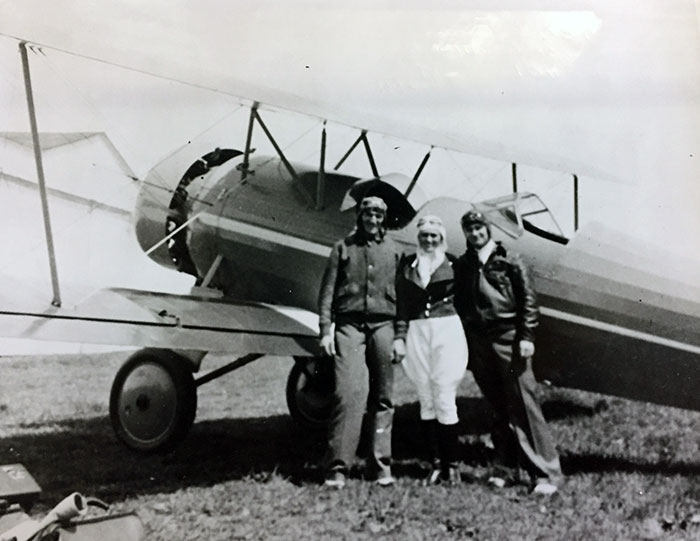 |
More about the flights to the NAR, as well as other flight activities pursued by Engle, are informally exhibited in a scrapbook Engle kept during the 20s, 30s and 40s. You can view the scrapbook at the link (PDF 2mB). Some of the people listed above and below on this page appear in articles in the scrapbook. Some other Register pilots, for example Alice duPont (page 17) and George Zinn (page 9), also appear.
Engle also attended the 1935 NAR. From Logbook #2, we can trace that flight to the NAR, which was held again in Cleveland, OH August 30th-September 2nd. Below, abridged from Log #2 page 5, is his itinerary. He flew the Pitcairn Mailwing NC10377 round trip.
 |
And below is a photograph with Vansant and Engle at center. The other people were unidentified. The airplane is an unidentified Stinson.
 |
Along the path of his flying career, Engle earned Transport pilot certificate T5194. Below, his Transport pilot authority was authenticated by his State of Pennsylvania pilot identification card (in the early days of aviation many local bureaucracies required pilots to have local ID cards, which brought a few dollars into local economies -- Engle even had one for the city of Atlanta, GA).
 |
Regardless, if you wonder what the federal certificate number T5194 means, know that they were awarded in numerical order in the early days. His fellow Pitcairn Register signers such as Charles Lindbergh flew with T69, Cloyd Clevenger held T141 and Dewey Noyes earned T479. Engle also earned a mechanic's certificate, M16684.
William Engle was born October 17, 1904 in Philadelphia, PA (but see magazine article below). The 1910 U.S. Census, his first, placed him living with his parents on a farm in Phiadelphia. His father, Harry C. (43) was a farmer. His mother, Susan C. (39) was a housewife. He had one older brother, Aaron (18), who was coded as married. No record that Aaron's wife was living with him was in that Census. Charles H. Patter (35), a hired hand, lived with them. In 1920, the Census recorded Engle (17) living at the same farm with both his parents. His occupation was coded as "farm laborer."
The 1930 Census placed him at age 27 living at 1357 72nd Avenue, Philadelphia, PA. He lived with his parents and the Census identified his marital status as married. Edith H. Engle (25) lived in the household and appeared to be Engle's wife. I found no record of their wedding, although the Census coded their marriage date as 1928. Engle's son stated, "I know basically nothing about his first marriage except it was 'short,' it wasn't discussed."
Curiously, given the biographical information in the article below, his occupation was coded in 1930 as a "bank clerk" in the "banking" industry. No mention was made of aviation. Engle's son corroborates the Census, stating about the bank work, "... Dad was a bank employee in the '30's; his uncle owned a bank and it was a steady source of income while keeping the Silver Star Airport afloat."
SPONSORED LINKS
Indeed, in the summer of 1928, Engle took over ownership of the Silver Star Airport, Langhorne, PA. At the link is the history of the airport as well as photographs of Engle. The Philadelphia Inquirer, March 23, 1930 documented his early efforts, below. The "Challenger" mentioned in the last sentence is most likely NC284K (see above)
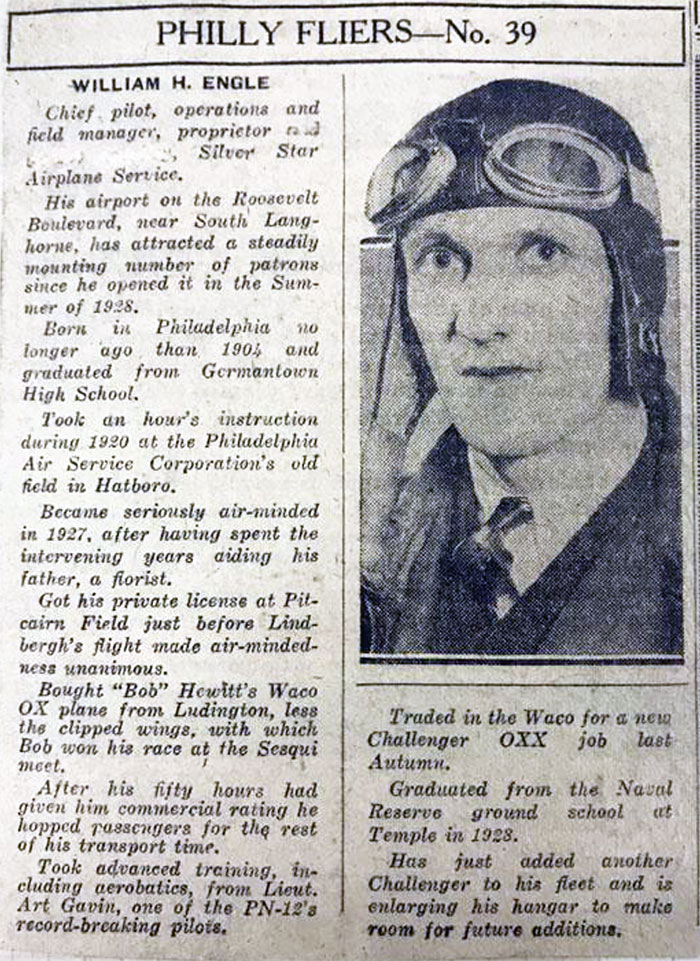 |
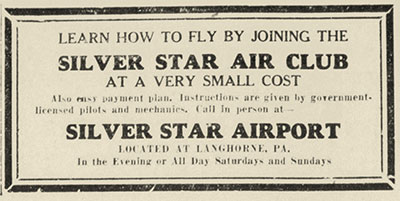 |
A print advertisement appeared in the Bristol Daily Courier (PA), August 22, 1930, left. A similar ad appeared in Daily Courier of September 5, 1932. Silver Star transferred to another owner and closed in the 1970s. It is now, like many old airfields, a shopping mall.
Many hours of "Stud. Inst." appear in his pilot logs through the 1930s into the 40s, reflecting the bulk of the work he performed at Silver Star and surrounds. The first entry of a flight in a military airplane appeared on December 21, 1940 in his Logbook #4, page 36. He flew 39-719 (see above). He was active in state aviation organizations also. The article at right from The Philadelphia Inquirer, March 29, 1932 documented his membership in the Aero Club of Pennsylvania. Over 30 years later, a news article that appeared in the Bucks County Courier Times, March 26, 1969 provided a retrospective for the Silver Star Airport and reported on Engle's withdrawal from the airport management role.
The Philadelphia Inquirer Aero Club Gets New Members |
I found one U.S Immigration form that documented Engle's voyage aboard the S.S. Rotterdam sailing from New York September 10-23, 1938 and return. He traveled with his wife, Esther Van Sant Engle (m. 1938), both living at 210 Jefferson Avenue, Bristol, PA. There was no mention of itinerary on the form, but, separately, his flight Logbook #2, page 32, for September 26, 1938 mentions, in a comment after one of his flights, a "return from S. America," which suggests a possible sailing route. We might further deduce theirs was a honeymoon cruise.
In the 1940 Census, coded April 12th, Engle was listed as a "guest" in the home of V. Gibson Vincent in Boonton, NJ, about 25 miles NW of New York City. His occupation was listed as "test piloting" for an aircraft corporation, probably Fleetwings. Also in the same house were Milton Anderson, identified as an aircraft mechanic, and Thomas Knox, identified as an aeronautical engineer. We can imagine this living arrangement was due to an assignment away from the Fleetwings base is Bristol, PA.
Engle's pilot logbook #3, page 11, for March 28, 1939 records a demonstration of Fleetwings F502 NC19191 to Howard Hughes in Nassau, Bahamas. This voyage to Florida and the Bahamas was documented in the news (publisher unknown) article below.
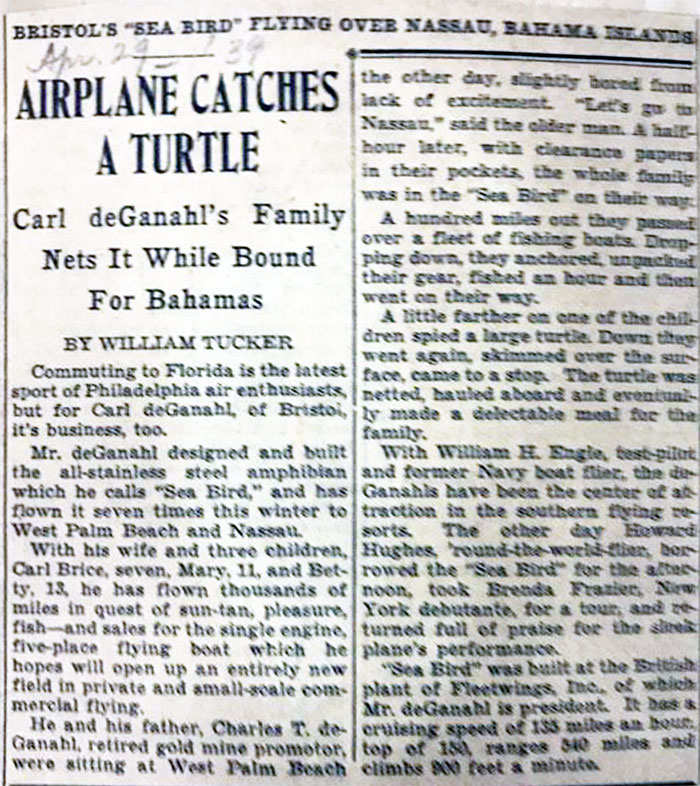 |
His Logbook #5, page 16, recorded on December 7, 1941 a 20-minute instructional flight. Similar entries on the 8th through the 12th were logged without note about the declaration of war and the beginning of WWII.
Not that the Fleetwings factory was without WWII intrigue. The article below gives a history of German spy activity aimed at the Fleetwings company, especially regarding a new plane model.
Bucks County (PA) Courier Times, July 1, 2019 By Carl LaVO / Correspondent I’ve snagged many interesting Bucks County stories to tell over the years. Somewhere near the top is a reminiscence from Katharine Ritter Wallace of McLean, Virginia. Her father [left] recruited and supervised Nazi espionage agents in Britain, America and North Africa from 1936 to 1941. Their aim was to swipe aviation secrets. Katharine hoped I could resolve a question about Col. Nikolaus Ritter’s rendezvous in 1937 with his Doylestown agent working at a nearby seaplane factory “on the Susquehanna River.” I chuckled. “Your dad probably meant Fleetwing Aviation on the Delaware River in Bristol. Seaplanes were built there, only 30 miles from Doylestown.” Katharine had been translating into English her dad’s German memoir, an insider’s view of being Adolf Hitler’s spy handler. “Cover Name: Dr. Rantzau” was recently published by Kentucky University. An advance copy arrived at my doorstep a few weeks ago. Ritter was a wounded German infantry officer in World War I who immigrated to the United States in 1924, became a businessman, gained fluency in Americanized English, married a schoolteacher and fathered two children. In 1935, the family left for Germany, in part so the kids could meet their gravely ill paternal grandfather. That year, Ritter joined the Abwehr (“Repulse” in German), a new intelligence agency of the Third Reich. Ritter was chief of air intelligence whose assignment was to gather data on enemy airfields, aircraft and state-of-the-art technology. Ritter’s grasp of English made him ideal as a roving spy recruiter and organizer. He used many aliases while drifting around Europe and the United States. In Holland, he was Dr. Rantzau. In Belgium and Luxembourg, Dr. Reinhard. In Hungary, Dr. Jansen. In the U.S., Alfred Landing, or simply “Mr. Johnson.” In 1937, Ritter returned to the United States to meet individually with his spies. Within months, he personally secured plans for Norden Corp.’s ultra-secret bombsight and Sperry Corp.’s gyroscope that he smuggled back to Germany. Both would help propel Hitler’s Luftwaffe into the world’s most devastating air force by 1939.
During his spy-to-spy tour, Ritter arrived by bus in Doylestown to see one of them. He was at work, but his wife offered to drive the colonel to the factory, which she said was building “flying boats for the Navy.” [image, right, from the article] “Is just anyone allowed to drive in there?” he asked. “Why not?” she replied. Stopping at a coffee shop outside Fleetwing, a waitress mistook “Mr. Johnson” for a new employee. Then a “short, lively man in shirt sleeves came in, saw me, sat next to me, and greeted me in German like an old acquaintance. ‘You are Mr. Johnson?’ “I delivered regards from (codename) ‘Kurt’ in Hamburg, and told him that Kurt was wondering why he had not heard from him for such a long time. ‘That’s just like him,’ the little fellow laughed. ‘Well, we did not have anything for him in the past two years.’ ” Ritter braced as the agent openly discussed in German things “that should have been secret. He made fun of my dismayed expression. ‘Calm down,’ and pointed toward the hostess. ‘Annie here can listen in on everything. First of all, she doesn’t know a word of German, not even Pennsylvania Dutch. ... Come on. Let’s go over, and I’ll show you the shop.’ I had to gasp for air and went along with him.” The facility was old. “The little fellow saw how disappointed I was. ‘Don’t worry,’ he said. ‘Now everything is being modernized. We have a big order from the naval air arm. Let’s get over there and take a look at the model boat.’ ” Which they did without interference. Out of earshot, the two discussed how intel should be handled. The spy was reluctant to send it by mail to New York; a flurry of letters might raise suspicion. Ritter suggested St. Louis. “You’ll get your re-routing address as soon as possible, but to begin with, we must do a careful trial run. First, just write two harmless letters so we can see if everything is clear. Then, we can begin with your confidential reports.” "‘How am I to send them?’ he asked. ‘Microphotography. ... I’ll send you an agent who will initiate you in the mysteries of microphotography, and from then on, don’t use anything else for your reports.’ ” Mr. Johnson bade “auf wiedersehen” and boarded a train for St. Louis. Unfortunately for him, one of his recruits became a double agent, leading the FBI to take down the spy ring in 1941. Thirty-three agents were arrested and convicted. Ritter evaded capture and was reassigned to German air defenses. After the war, the British incarcerated him for two years. He then faded from the scene until his family urged him to write his memoir before his death in 1974. Thanks to his daughter, the conversational account at last tells his story for an American public. |
As with most U.S. males, regardless of age, as the threat of WWII developed, Engle was called to register with his draft board on October 16, 1940. His registration card is below. He was 35 years old and employed by Fleetwings of Bristol, PA. He was 5'10" and 147 pounds.
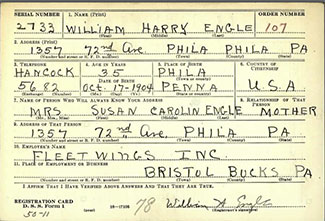 |
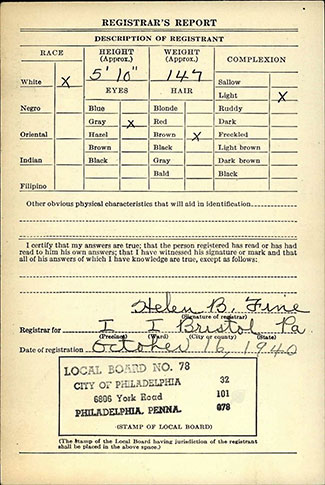 |
Engle continued flying for Fleetwings, which became a division of Kaiser Cargo, Inc. in 1942 (the company also made Liberty ships at another location).
He remained an active test pilot through WWII, flying not only Fleetwings, but for the Navy flying other makes of aircraft as well.
The photograph below shows Engle standing in the hatch of a Fleetwing Sunbird F-5, NC19191, on August 23, 1944. He appears to be helping passengers in or out of the airplane. Notice what appears to be the livery of the Civil Air Patrol painted on the side of the fuselage. The people were unidentifed. On close examination, both Engle and the gentleman on the left have company photo identifications on their belts. And the woman is wearing "nylons" with seams in the back. The photograph was probably taken at Kaiser Field, Levittown, PA.
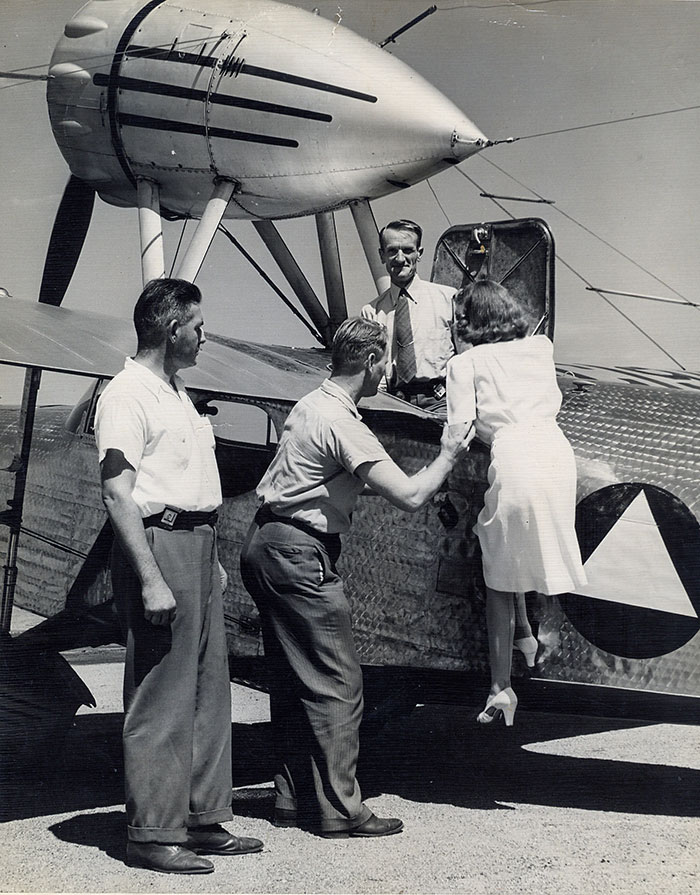 |
How do we know about this photograph? Because we have Engle's pilot Logbook #6, page 23 (last line), below, that records at lower left the flight on the 23rd, the date on the photograph. The aircraft registration number was clear, NC19191, as was the purpose of the flight: "First pass.[enger] flight - Kaiser Field." Note the machine turned pattern on the airplane's fuselage.
 |
The March 1945 issue of Fleetwings, the company news magazine, below, provided a summary of his activities with the company as Fleetwings' Chief Test Pilot and Manager of Flight Operations. I spliced magazine pages 13 and 32 together.
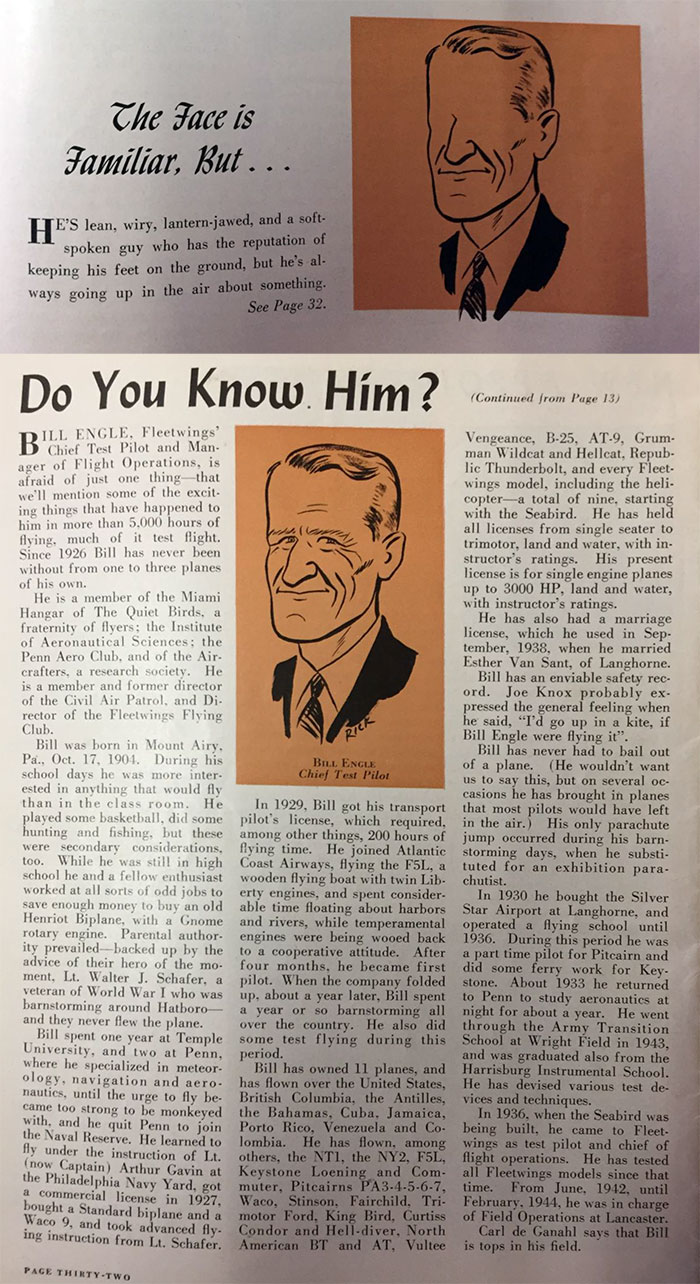 |
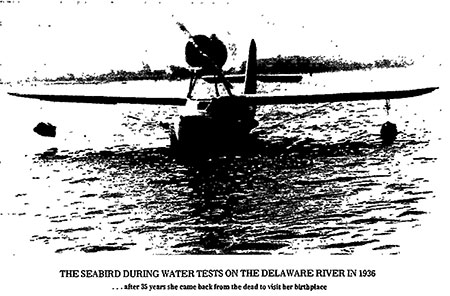 |
An interesting aside involves Model F401 Seabird N16793 (not a Register airplane), manufactured by Fleetwings in 1936. Engle flew this airplane over a dozen times between March and August 1937 (Logbook #2). According to the FAA database, it still exists and is currently owned by Yellowstone Aviation, Inc. in Wyoming. It used to belong to Channing Clark (1916-2004). Clark flew his Seabird back "home" to Bristol, PA as documented in the Bucks County Courier Times (PA), August 25, 1971. Photo, right, from the article, which is available in-full at the link. According to the article, among the people that greeted the airplane at Bristol was Bill Engle and a group of other people who worked for Fleetwings.
William Engle flew West September 29,1978 at Langhorne Manor, PA. He carried with him Transport pilot certificate T5194 and mechanic's certificate M16684. Channing Clark sent a heartfelt letter dated October 10, 1978 to Engle (in the absence of knowledge he had passed away eleven days earlier). The two-page (hand-written!) letter is below. It is filled with warm praise and serves as a modest and humorous send-off for Engle's place in the sky.
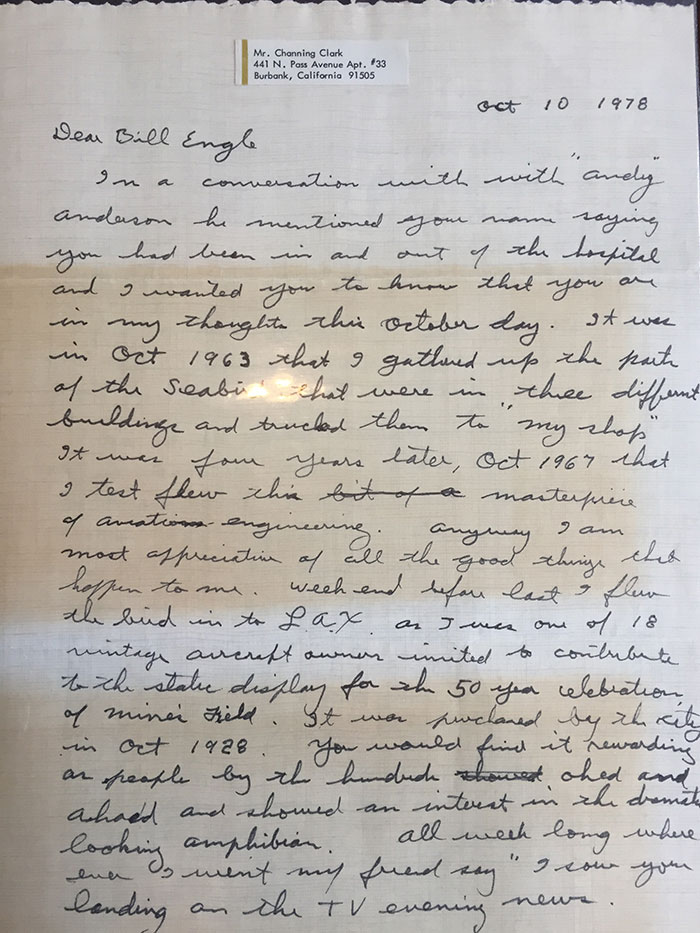 |
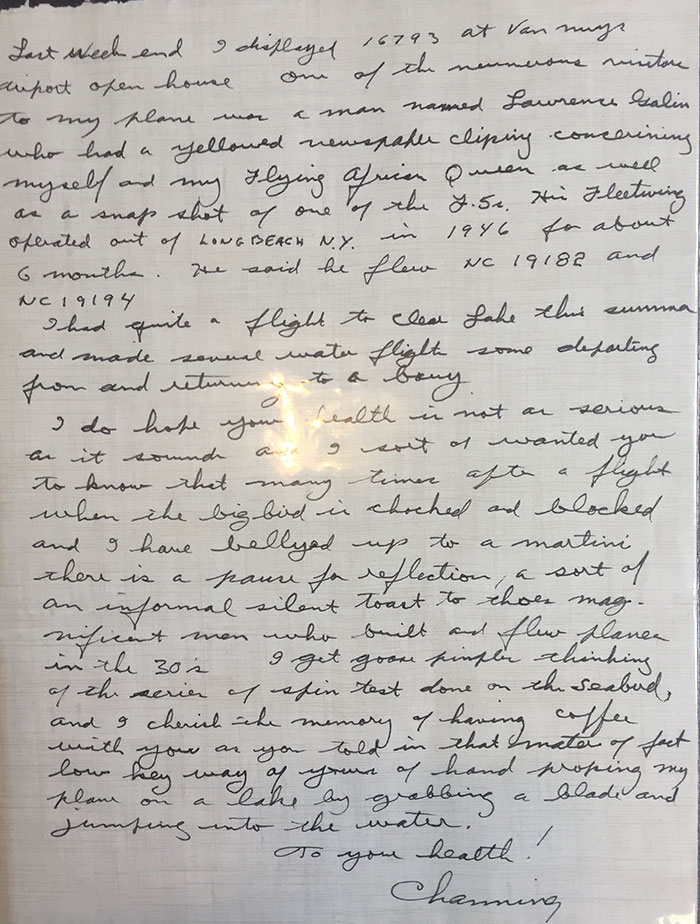 |
UPDATE of December 4, 2020. A news article in the Bucks County Courier Times (PA), November 9, 1920, featured Engle and his Silver Star Airport in a history of air mail service in Pennsylvania. See the link to Clifford Ball for more information about air mail in Pennsylvania.
---o0o---
SPONSORED LINKS
THIS PAGE UPLOADED: 07/08/20 REVISED:

